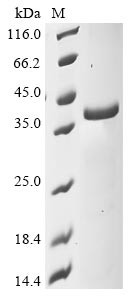Amino acids 37–310 constitute the expression domain of recombinant Mouse Sirt5. This Sirt5 protein is expected to have a theoretical molecular weight of 37.6 kDa. This Sirt5 protein is produced using e.coli expression system. The Sirt5 gene fragment has been modified by fusing the N-terminal 10xHis tag and C-terminal Myc tag, providing convenience in detecting and purifying the recombinant Sirt5 protein during the following stages.
The mouse NAD-dependent protein deacylase sirtuin-5, mitochondrial (Sirt5) is an enzyme belonging to the sirtuin family. Sirtuins are involved in various cellular processes, including metabolism, aging, and stress response. Specifically localized in the mitochondria, Sirt5 plays a role in regulating protein post-translational modifications, including desuccinylation, demalonylation, and deglutarylation. By deacylating target proteins, Sirt5 influences metabolic pathways and contributes to the maintenance of mitochondrial function. Its deacylase activity has implications for cellular energy metabolism, oxidative stress response, and metabolic homeostasis. Understanding the functions of Sirt5 may offer insights into mitochondrial biology and potential therapeutic avenues for metabolic disorders and age-related conditions.






